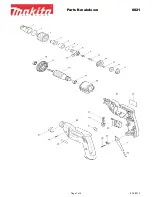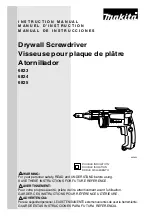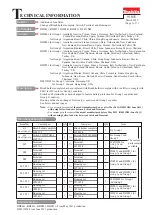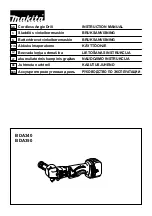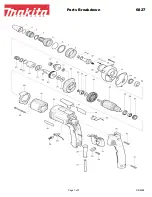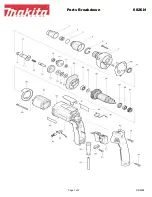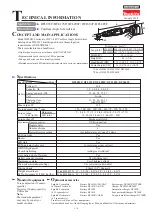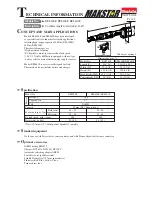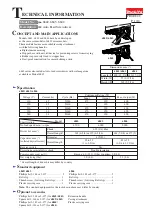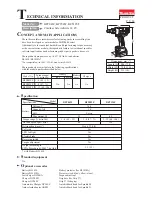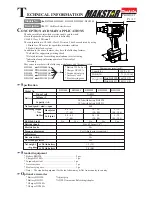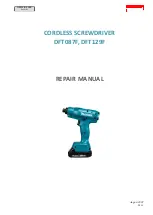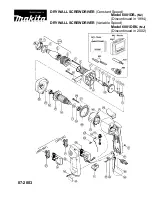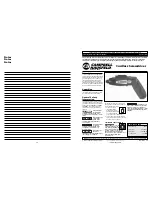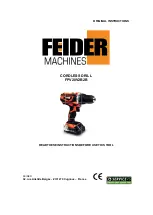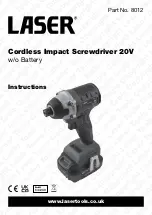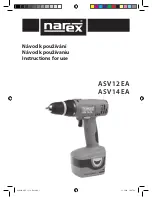
- 8 -
STARTING AND STOPPING
!
!
IMPORTANT! Before starting the electrical tool it is compulsory
to wear protection goggles, gloves and headphones (not provided).
!
!
IMPORTANT! Make sure nobody is approaching the working
area while the tool is running.
Starting
1) Insert the charged battery in the drill.
2) Position the rotation direction switch
(Fig. A pos.2)
in one of the
two operating positions
(not in the centre).
3) Firmly grasp the hand grip
(Fig. A pos.8)
in your hand.
4) To start press the button
(Fig. A pos.1)
.
The switch is a ‘maintained action’ switch so the electrical tool will
stay on when you keep the switch pressed.
Stopping
To stop the drill release the switch
(Fig. A pos.1)
.
If you notice any working defects, switch off the electrical tool and
consult the chapter “Problems, causes and solutions”.
When not using the tool, turn it off.
OPERATIONAL TIPS
After reading the previous chapters carefully, apply these tips scrupu-
lously to obtain maximum performance.
Proceed calmly so as to become familiar with all the controls; after
having gained sufficient experience you will be able to make full use
of its potential.
ELECTRONIC CHUCK SPEED ADJUSTMENT
Press the switch
(Fig. A pos.1)
gradually until the desired speed is
reached. With less pressure low speeds are obtained, whereas with
more pressure high speeds are obtained.
CHUCK ROTATION DIRECTION REGULATION (fig. C)
IMPORTANT! The rotation direction inversion operation must be
performed with the tool off and the chuck stationary.
For drilling operations and tightening right thread screws (clockwise),
move the rotation direction switch
(Fig. A pos.2)
to ‘
R
’.
For unscrewing operations, or removal of embedded bits and tightening
left thread screws (anti-clockwise), move the rotation direction switch
(Fig. A pos.2)
to ‘
L
’.
MECHANICAL CHUCK SPEED ADJUSTMENT
IMPORTANT! The mechanical speed adjustment operation must be
performed with the tool off and the chuck stationary.
By moving the switch
(Fig. A pos.10)
it is possible to mechanically
select the desired speed.
Speed 1: low number of revolutions and high torque (for holes with a
large diameter or screwing large screws into a hard material).
Speed 2: high number of revolutions and low torque.
FRICTION REGULATION
The friction can be adjusted from
‘1’
to the maximum setting
and
normally only needs adjusting for screwing operations. Using the
ring nut to vary the tightening torque
(Fig. A pos.5)
, match up one
of the values indicated with the reference on the top of the drill body,
remembering that:
- ‘
1
’ corresponds to minimum torque, to use for screw small screws
in soft material.
- the torque increases with the number indicated on the ring nut until
the maximum value is reached , to use for drilling.
LIGHTING FOR WORK AREA
The light
(Fig. A pos.7)
comes on or off automatically when the tool
is switched on.
CHANGING THE CUTTING TOOL
See chapter “STARTING UP”.
DRILL BITS
Buy good quality bits, with a suitable connection for the characteristics
of the chuck and suitable for the material to be drilled. Contact your
retailer who will be able to give you the best advice.
Our company produces a wide range of bits suitable for the various
uses (metal, wood, brick, etc.).
DRILLING OPERATION
Always secure items in a vice when drilling. Use a punch to mark the
initial drilling point. Keep the drill bits sharp. To drill large holes first
drill a number of small holes to avoid the bit jamming in the hole and
thus overloading the tool.
Reduce the drilling pressure when the bit is nearly out of the item.
Be cautious with the sawdust produced which is very hot and also
very sharp. Wear goggles and protective gloves!
Drilling metal
Use HSS bits. If the item is a thin metal sheet, place a block of wood
under the metal sheet to prevent the bit getting stuck.
To drill a cast iron item, use bits suitable for this material.
With steel items, use special liquid coolant; with aluminium use paraffin
as a coolant, whereas with brass and cast iron do not use liquids but
take the bit out of the hole frequently to allow it to cool down.
Drilling wood and plastic
Always use bits that are suitable for drilling wood and plastic. Keep
in mind that they are fragile materials and it is possible that the item
can crack during drilling.
SCREWING INSERTS (BITS)
Buy only high quality inserts with connection suitable for the characte-
ristics of this screwdriver and with a push rod suitable for the screws in
use. Contact your retailer who will be able to give you the best advice.
Our company produces a wide range of inserts suitable for the various
uses.
SCREWS
It is important to use high quality bolts and screws so as to obtain the
best possible final result. For each kind of material to be fixed there
is a suitable type of bolts and screws; therefore, buy it according to
necessity. If necessary, use washers to increase the surface area.
SCREWING OPERATION
Place the screw on the panel to be fixed and with a hammer tap it
lightly in a perpendicular position.
For some materials it is necessary to make a pre-hole in order to
facilitate the screwing and to prevent the panel breaking (especially
with wood and plastic).
Grip the screwdriver firmly with one hand and insert the tip of the bit
in the screw head. Lightly press on the screw and run the screwdriver,
activating the switch gradually so as to modulate the rotating speed
and, consequently, the speed of screw penetration.
At the end of this operation, which usually lasts a few seconds, remove
the screwdriver and turn it off by releasing the switch.
The screwing speed depends on the following factors: panel material,
screw size, thread, presence or absence of a pre-hole, etc.
After the screwing phase, the internal rotation joint will be uncoupled,
the electrical tool will become very noisy and will vibrate; now, remove
the screwdriver and turn it off.
Continuing to screw may cause: the breakage of the insert, damage
to the screw head, and failure of the electrical tool (in this case not
covered by the warranty). In this case, unscrew the screw, perform a
pre-hole with a driller and re-screw modifying the adjustments.
Do not force screws that do not screw!










